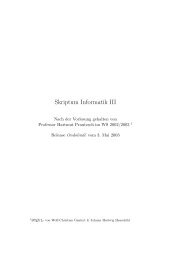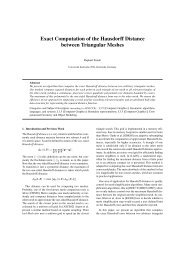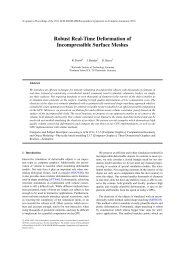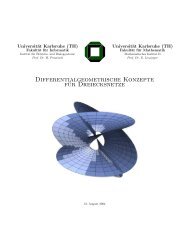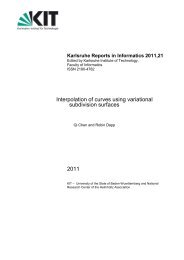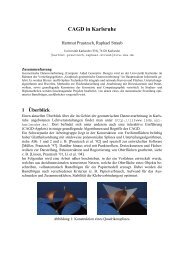On the Convergence and Correctness of Impulse-Based Dynamic ...
On the Convergence and Correctness of Impulse-Based Dynamic ...
On the Convergence and Correctness of Impulse-Based Dynamic ...
You also want an ePaper? Increase the reach of your titles
YUMPU automatically turns print PDFs into web optimized ePapers that Google loves.
- 10 -<br />
∆ vr( X)<br />
is <strong>the</strong> total change <strong>of</strong> <strong>the</strong> velocity <strong>of</strong> <strong>the</strong> point mass P r , if <strong>the</strong> impulses defined by X act<br />
on <strong>the</strong> PMS. We have to sum up <strong>the</strong> effects for all constraints in which P r is involved, i.e., for all<br />
constraints Ck : = ( ik, jk, dk)<br />
for which ik= r (positive sign) or jk= r (negative sign).<br />
The relative velocity P& jk − P&<br />
i on <strong>the</strong> constraint C<br />
k<br />
k is <strong>the</strong>refore changed by <strong>the</strong> value<br />
∆ w ( X): =∆v ( X) −∆ v ( X)<br />
.<br />
k jk ik<br />
Exp<strong>and</strong>ed, this results for a specific joint Cr = ( ir, jr, dr)<br />
in<br />
∆ w ( X): =∆v ( X) −∆ v ( X)<br />
=<br />
(4.4)<br />
r jr ir<br />
⎛ m ⎞ ⎛ m<br />
⎞<br />
= (1/ mj ) ⎜ sig( k, j ) (1/ ) ( , ) .<br />
r r Ak ⋅xk ⎟− mi ⎜ sig k i<br />
r<br />
r Ak ⋅xk<br />
⎟<br />
⎜∑ ⎟ ⎜∑ ⎟<br />
⎝ k= 1 ⎠ ⎝ k=<br />
1<br />
⎠<br />
With <strong>the</strong> introduced notation, we can now establish <strong>the</strong> required equations for <strong>the</strong> x k in that we<br />
attempt to satisfy (2.2):<br />
(4.5) ∀ k = 1,..., m: ( P −P )( P& − P& +∆ w ( X))<br />
= 0.<br />
jk ik jk ik k<br />
With <strong>the</strong> abbreviated notation (2.3) we obtain<br />
Ak ⋅ ( A& k +∆ wk( X)) = 0 ( k = 1,..., m)<br />
.<br />
We can now transfer <strong>the</strong> terms without X to <strong>the</strong> right side, <strong>and</strong> obtain a system <strong>of</strong> linear equations<br />
(4.6) Ak ⋅∆ wk( X) =−Ak ⋅ A& k ( k = 1,..., m)<br />
.<br />
For a specific joint C = ( i , j , d ) this results in <strong>the</strong> equation<br />
r r r r<br />
(4.7)<br />
⎛ m ⎞ ⎛ m<br />
⎞<br />
(1/ mj ) ⎜ sig( k, j ) (1/ ) ( , )<br />
r r ArAk ⋅xk ⎟− mi ⎜ sig k i<br />
r<br />
r ArAk ⋅ xk ⎟=−Ar<br />
⋅A&<br />
r<br />
⎜∑ ⎟ ⎜∑ .<br />
⎟<br />
⎝ k= 1 ⎠ ⎝ k=<br />
1<br />
⎠<br />
Since we are striving for an SLE <strong>of</strong> <strong>the</strong> form<br />
(4.8)<br />
⎛x1 ⎞ ⎛b1 ⎞<br />
⎜ ⎟ ⎜ ⎟<br />
⎜<br />
x2 ⎟ ⎜<br />
b2<br />
⎟<br />
M ⋅ X = M ⋅ ⎜. ⎟= ⎜. ⎟=<br />
B,<br />
⎜ ⎟ ⎜ ⎟<br />
⎜. ⎟ ⎜. ⎟<br />
⎜x ⎟ ⎜<br />
m b ⎟<br />
⎝ ⎠ ⎝ m⎠<br />
we must now extract <strong>the</strong> elements M[,] rs <strong>of</strong> <strong>the</strong> matrix M . (4.7) represents <strong>the</strong> r-th row <strong>of</strong> <strong>the</strong><br />
SLE. It <strong>the</strong>refore delivers all matrix elements M[,1... r m ] . Because <strong>of</strong><br />
M[,] r s = (1/ m ) sig(, s j ) A A − (1/ m ) sig(, s i ) A A<br />
<strong>the</strong> result for r ≠ s is<br />
j r r s i r r s<br />
r r



